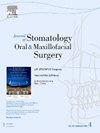在面部重建中使用颞浅蒂作为微血管吻合术受体部位的实用性:对 94 例病例的回顾性研究。
IF 2
3区 医学
Q2 DENTISTRY, ORAL SURGERY & MEDICINE
Journal of Stomatology Oral and Maxillofacial Surgery
Pub Date : 2024-10-09
DOI:10.1016/j.jormas.2024.102113
引用次数: 0
摘要
在颅颈面部整形手术中,使用游离皮瓣是公认的首选治疗方法。多种前因可能会使外科医生陷入血管荒漠的境地。我们的研究旨在报告和分析我们在一次和二次整形手术中使用颞部血管的经验。我们在 2010 年 1 月 1 日至 2023 年 3 月 31 日期间进行了一项回顾性研究。研究对象包括使用游离皮瓣进行颅颈颌面部重建,并将颞浅蒂作为血管吻合的受体部位的患者。根据重建类型、位置和游离皮瓣失败的风险因素,对早期和晚期并发症及失败率进行了分析。共有94名患者使用与颞浅蒂吻合的游离皮瓣进行了颅颈面部重建(主要或次要情况)。10名患者接受了上1/3颅骨重建,58名患者接受了中1/3颅骨重建,26名患者接受了下1/3颅骨重建。总并发症发生率为28.7%(21.3%为轻微并发症,7.4%为严重并发症)。我们的研究证明了颞浅基底的可靠性,无论是在初次手术中(成功率为 93.9%)还是在二次手术中(成功率为 89.3%),以及在任何需要重建的颅颈面部层次中的通用性。这项研究证明了在颅颌面重建手术中保留颞浅骨蒂的价值。因为颞浅蒂是重建中上三度颅骨的首选受区,无论是在初次手术中,还是在再次手术中,颞浅蒂都是首选受区。本文章由计算机程序翻译,如有差异,请以英文原文为准。
Usefulness of using the superficial temporal pedicle as the recipient site for microvascular anastomosis in facial reconstruction: A retrospective study of 94 cases
In cranio-cervico-facial reconstructive surgery, it is accepted that the use of free flaps is the treatment of choice. The multiple antecedents can place the surgeon in situations of vascular deserts. The aim of our study is to report and analyse our experience of the use of temporal vessels in primary and secondary reconstructive surgery. A retrospective study was conducted between 01/01/2010 and 31/03/2023. Patients who underwent cranio-cervico-facial reconstruction using free flaps, with use of the superficial temporal pedicle as the recipient site for the vascular anastomosis were included. Early and late complication and failure rates were analysed according to type of reconstruction, location and risk factors for free flap failure. A total of 94 patients underwent craniocervical-facial reconstruction using a free flap anastomosed to the superficial temporal pedicle (in primary or secondary situations). Ten patients underwent reconstruction of the upper third, 58 the middle third and 26 the lower third. With an overall complication rate of 28.7% (21.3% minor complications and 7.4% major complications). Our study proves the reliability of the superficial temporal pedicle, both in the primary situation (with a success rate of 93.9%) and in the secondary situation (with a success rate of 89.3%), as well as its versatility whatever the cranio-cervico-facial level to be reconstructed. This study demonstrates the value of preserving the superficial temporal pedicle in craniofacial reconstruction surgery. This is because it is a preferred recipient site for reconstructions of the upper and middle thirds in the primary situation or in the event of recourse.
求助全文
通过发布文献求助,成功后即可免费获取论文全文。
去求助
来源期刊

Journal of Stomatology Oral and Maxillofacial Surgery
Surgery, Dentistry, Oral Surgery and Medicine, Otorhinolaryngology and Facial Plastic Surgery
CiteScore
2.30
自引率
9.10%
发文量
0
审稿时长
23 days
 求助内容:
求助内容: 应助结果提醒方式:
应助结果提醒方式:


